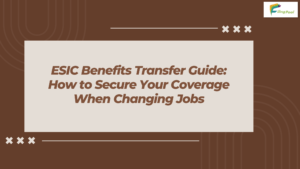
Introduction: ESIC Safety Net and Job Transitions
Starting a new job is exciting, but it often comes with HR-related concerns. One of the most important questions employees ask is: “What happens to my ESIC benefits when I change jobs?”
Many employees mistakenly think their ESIC coverage ends with their old employer or that they must restart the process. This confusion can lead to gaps in crucial medical and financial protection.
The truth is, your ESIC benefits are portable. You don’t lose them when you switch employers, provided you follow the correct process. In this blog, we’ll explain ESIC portability, why it matters, and the exact steps to ensure a seamless transition.
Pro Tip: FilingPool helps employees and employers handle ESIC compliance effortlessly, ensuring benefits remain active without disruption.
Understanding ESIC Benefits
The Employees’ State Insurance Corporation (ESIC) provides social security benefits to employees in India, funded by contributions from both employers and employees.
Key Benefits of ESIC:
- Medical Care: Free medical treatment for employees and dependents.
- Maternity Benefits: Paid leave and medical expenses for insured women.
- Disability Benefits: Financial support in case of temporary or permanent disability.
- Sickness Benefits: Cash compensation during certified sickness.
- Dependents’ Benefits: Pension to dependents in case of an employee’s death.
Eligibility Criteria:
- Employees earning up to ₹21,000 per month (₹25,000 for persons with disabilities) are covered.
- Both employer and employee must contribute to the ESIC fund.
ESIC Portability: The Core Concept
Unlike some benefits that reset with a new employer, ESIC works on a lifelong Insurance Person (IP) Number.
- What is an ESIC IP Number?
It is a unique, permanent identification number issued to every insured employee. Think of it as the ESIC equivalent of your PAN or UAN number. - Why It Matters:
- You don’t transfer contributions.
- You simply carry your same IP number to your new employer.
- Your medical and cash benefits remain linked to this number, ensuring continuity.
Step-by-Step Guide to Transferring ESIC Benefits
| Stage | What You Need to Do | Why It Matters |
| Before Leaving Old Job | Confirm your IP number is active and details (name, DOB, etc.) are correct in the ESIC system. Inform your HR that you’ll continue with the same IP number. | Prevents duplicate IP numbers being created. |
| Joining New Job | Provide your existing ESIC IP number during onboarding. New HR will register you under their ESIC code using this number. | Ensures your contributions continue seamlessly. |
| Post-Joining | Verify your new employer is remitting contributions under the same IP number. Check status on the ESIC portal. | Maintains eligibility for medical and cash benefits. |
Why Transferring ESIC Benefits is Crucial
Failing to carry forward your ESIC IP number can cause serious issues:
- Uninterrupted Medical Coverage: You remain eligible at ESIC hospitals and dispensaries without waiting periods.
- Cash Benefits Protection: Benefits like sickness and maternity require a minimum contribution history. Portability ensures no break in this record.
- Avoiding Duplication: New IP numbers may cause compliance issues and split benefit history.
Common Challenges in ESIC Transfers (and How to Overcome Them)
Challenge 1: New employer creates a new IP number.
- Solution: Insist on using your old IP number. FilingPool can guide your HR team to avoid errors.
Challenge 2: Data mismatch (name, father’s name, DOB).
- Solution: Update ESIC details with accurate documents before joining a new job.
Challenge 3: Multiple IP numbers already exist.
- Solution: Request ESIC to merge old and new IP numbers. FilingPool provides assistance in consolidating contributions.
Role of Employers in ESIC Benefit Transfer
Both old and new employers play an important role:
- Old Employer: Must close contribution submissions correctly without creating errors in records.
- New Employer: Must register the employee with the existing IP number, not create a duplicate.
- Collaboration: Cooperation between HR teams ensures a smooth transition.
Best Practices for a Smooth ESIC Transition
- Always keep a copy of your IP number and ESIC card.
- Cross-check your details on the ESIC portal before resigning.
- Provide accurate information to your new employer’s HR team.
- Follow up regularly until contributions reflect in your ESIC account.
- Stay updated with ESIC rules and changes via the official portal.
Frequently Asked Questions
Q1. Do I need to apply for a new ESIC number when I change jobs?
No, you must use your existing IP number throughout your career.
Q2. What happens if I get two IP numbers?
You must request ESIC to merge them. FilingPool can help you consolidate.
Q3. Can benefits lapse if my new employer delays contributions?
Yes, delayed payments can affect benefit eligibility. Always follow up with HR.
Conclusion: Protecting Your ESIC Benefits During Job Changes
Your ESIC IP number is for life. By ensuring your new employer uses it, you protect your healthcare and financial security during job transitions.
Even a small mistake can disrupt your benefits. That’s why expert help matters. FilingPool ensures ESIC compliance is handled seamlessly, so you can focus on your new role without worrying about losing coverage.
Call to Action: Get in touch with FilingPool today for professional ESIC assistance and secure your benefits without hassle.
